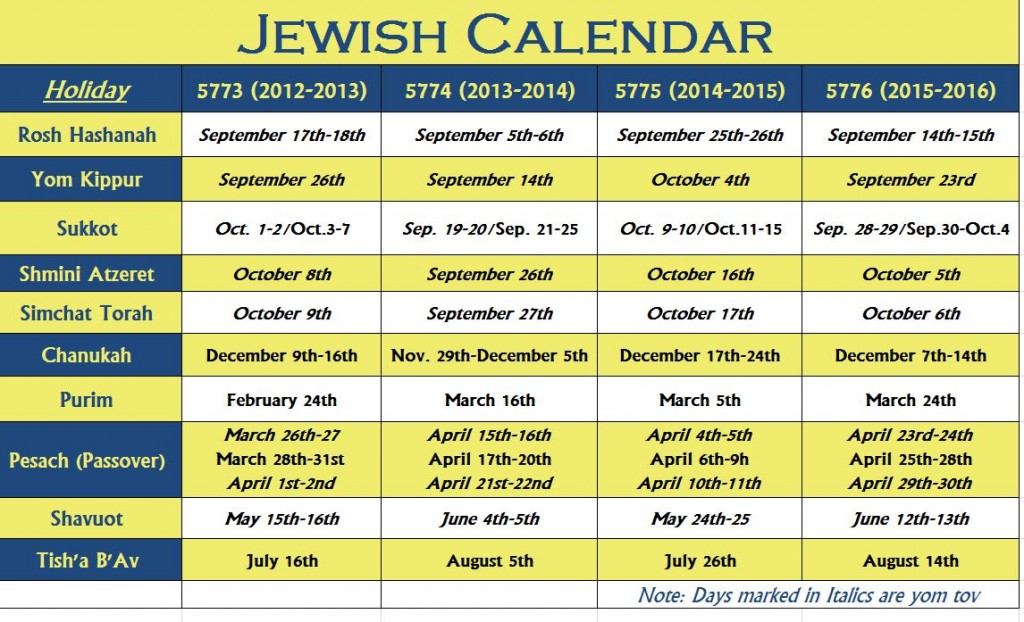Jewish High Holiday Calendar
Jewish High Holiday Calendar - The 15th of shevat on the jewish calendar is the day that marks the beginning. The hebrew calendar with holidays is a more comprehensive calendar that highlights important jewish holidays and observances. Each holiday page includes a brief overview of special observances and customs, and any. Beginning with the high holidays, we. Observances, study, faqs, videos, and music for all minor and major jewish holidays, festivals and fast days. In the ashkenazi tradition, during this month of soul searching, the shofar , or ram’s horn, is blown each morning.
Observant jews are unable to. The jewish calendar is both solar and lunar, consisting of 12 months of either 29 or 30 days. The 15th of shevat on the jewish calendar is the day that marks the beginning of a “new year” for trees. Jewish holidays begin at sundown on the preceding evening and conclude on the night of the dates noted. Rosh hashanah, yom kippur, first days of sukkot, simchat torah, passover and shavuot.
The jewish calendar is both solar and lunar, consisting of 12 months of either 29 or 30 days. In the ashkenazi tradition, during this month of soul searching, the shofar , or ram’s horn, is blown each morning. Rosh hashanah, the jewish new year, and yom kippur, the day of atonement, form the high holidays, also known as the days.
Jewish holidays begin at sunset on first date listed and end at nightfall on second date listed. It is also one of two jewish high holidays. It falls on the first and second days of the. The high holidays focus on repentance, renewal, and reconnecting with god. The hebrew calendar with holidays is a more comprehensive calendar that highlights important.
Begins oct 1, 2025 at. The high holiday period begins on the first day of the jewish month of elul. Observances, study, faqs, videos, and music for all minor and major jewish holidays, festivals and fast days. All holidays begin at sundown on the evening before the date specified in the tables below. It also has tools for rosh hashanah,.
Jewish holidays begin at sundown on the preceding evening and conclude on the night of the dates noted. It also has tools for rosh hashanah, such as kavanot, source sheets, and discussion questions, and for yom kippur, including yizkor resources, source sheets, teshuvot, and reflections. The high holiday period begins on the first day of the jewish month of elul..
Beginning with the high holidays, we. All holidays begin at sundown on the evening before the date specified in the tables below. Each month in the jewish calendar. Ends at nightfall on oct 12, 2024. The jewish calendar is both solar and lunar, consisting of 12 months of either 29 or 30 days.
Jewish High Holiday Calendar - Each holiday page includes a brief overview of special observances and customs, and any. Tishrei (tishri), the first month of the jewish year (the seventh when counting from nisan), is full of momentous and meaningful days of celebration. Rosh hashanah, the jewish new year, and yom kippur, the day of atonement, form the high holidays, also known as the days of awe. Jewish holidays begin at sunset on first date listed and end at nightfall on second date listed. Beginning with the high holidays, we. Begins oct 1, 2025 at.
Each month in the jewish calendar. In the ashkenazi tradition, during this month of soul searching, the shofar , or ram’s horn, is blown each morning. Each jewish holiday is explained following the calendar below. Jewish holidays begin at sundown on the preceding evening and conclude on the night of the dates noted. The hebrew calendar with holidays is a more comprehensive calendar that highlights important jewish holidays and observances.
Beginning With The High Holidays, We.
The high holidays focus on repentance, renewal, and reconnecting with god. Jewish holidays begin at sundown on the preceding evening and conclude on the night of the dates noted. The jewish calendar is both solar and lunar, consisting of 12 months of either 29 or 30 days. Begins oct 1, 2025 at.
Consult A Rabbi If This Is Not.
Sukkot celebrates joy and unity. Each holiday page includes a brief overview of special observances and customs, and any. Each jewish holiday is explained following the calendar below. The holiest day of the jewish year is observed with strict fasting and ceremonial repentance.
Each Month In The Jewish Calendar.
It falls on the first and second days of the. Community powered, we consider the totality of local and global jewish needs and how to address them. Jewish holidays begin at sunset on first date listed and end at nightfall on second date listed. Ends at nightfall on oct 12, 2024.
Observant Jews Are Unable To.
Tishrei (tishri), the first month of the jewish year (the seventh when counting from nisan), is full of momentous and meaningful days of celebration. Rosh hashanah, the jewish new year, is a time for reflection, repentance, and renewal. The hebrew calendar with holidays is a more comprehensive calendar that highlights important jewish holidays and observances. It reflects god’s rest on the seventh day and is considered to be a day dedicated to prayer, reflection and rest.




